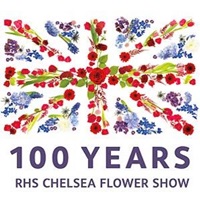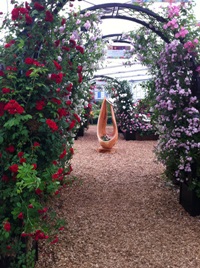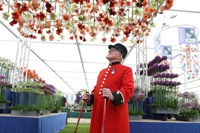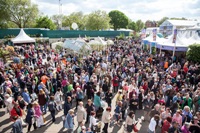
Established in 1913, on the grounds of the Chelsea Royal Hospital in London, the RHS Chelsea Flower Show has become one of the most celebrated annual events in the world and the world’s greatest showcase for horticultural excellence, attracting visitors and exhibitors from across the globe.

We take a look at the history behind the show and why it’s become such a national institution.
The origins of the RHS Chelsea Flower Show began in 1912 when Sir Harry Veitch, searching for a suitable place to host the Temple Show managed to secure the grounds of the Royal Hospital in Chelsea. It proved such a good site for an exhibition that the Great Spring Show, which later became known as the RHS Chelsea Flower Show, was moved there in 1913, where it has taken place almost every year since. Despite the First World War, the show was held 1914 – 1916, but was cancelled in 1917 and 1918.

Beautiful floral exhibits, displays and gardens have been displayed at the RHS Chelsea Flower Show for more than 100 years.
By the roaring 1920s, the RHS Chelsea Flower Show was back in full swing, the famous Chelsea tea parties were established and Royal visits resumed. In 1926 the show was held a week late due to the General Strike. Two year’s later, it was mother nature putting a dampener on the occasion as a heavy storm the night before the opening day caused the drains of the marquees became choked with hailstones and flooded. The next morning, the show opened with no sign of the previous night’s torrential storm after RHS staff and exhibitors worked through the night to clear debris and repair damage. It seems that exhibitors never fail to rise to the challenge of the temperamental British weather to maintain the prestige of this event.
In 1937, King George VI and Queen Elizabeth celebrated their Coronation Year, and to mark the occasion, a superb Empire Exhibition was staged. It featured wattles from Australia, pines from Canada, brilliant gladioli from East Africa and even a big prickly pear from Palestine.

A Chelsea Pensioner admires one of the floral exhibits in the Great Pavilion
The show was cancelled during the Second World War, as the land was required by the War Office for an anti-aircraft site. Some doubt arose as to whether the show would resume in 1947. The majority of exhibitors wanted a postponement, as stocks of plants were low, staff much depleted and fuel for greenhouses was obtainable only with special permits, but Lord Aberconway (then RHS President) and the RHS Council felt strongly that the show should resume as soon as possible. As it turned out, the show went ahead in 1947 and it was a great success.
In the 1950′s the Coronation of Queen Elizabeth II in 1953 was sufficient cause for a flower show that reflected the celebratory mood of the country. Most members of the Royal family attended that year. Unfortunately, due to a relentless stream of other commitments, the only Royal unable to attend was the Queen herself.
Today, the RHS Chelsea Flower Show is still viewed as the most important event in the horticultural calendar and is as popular as ever. It has grown from 244 exhibitors in 1913 to over 500 today and this year will attract 61,000 visitors from across the globe.

Today the show attracts tens of thousands of visitors a year
Over almost a century, the RHS Chelsea Flower Show has witnessed numerous changes in horticultural fashion. Show gardens, over the years, have mirrored the changing enthusiasms of garden designers – from the Japanese and topiary gardens of the early days (Japanese dwarf trees, now known as bonsai, were seen at the first Show in 1913), through the rock garden craze during the war years, the paved back yards and cottage gardens of the 1980s, to the contemporary sculptural gardens of the present day. The new trends constantly appearing at the show illustrate the changing face of garden design and mark this country’s ever-changing horticultural history.
Source: Interflora – The History of the RHS Chelsea Flower Show






